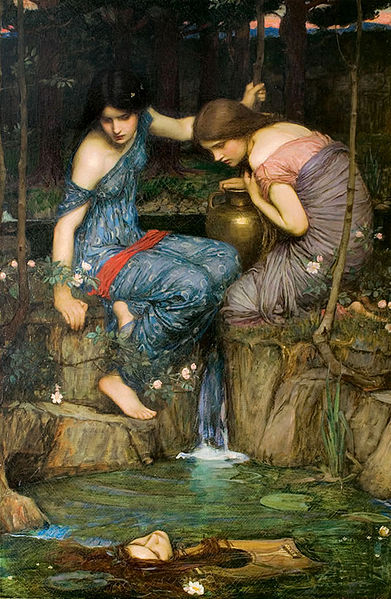Pre-Raphaelite art has its critics. I feel like many of them don’t actually look at the paintings or consider an artist’s individual work. They give it a cursory glance, assume that it’s all sentimentality and languorous women and then promptly dismiss it. A similar reaction takes place when people think of mythic fiction and fantasy, they mistakenly assume it’s all unicorns and fairies or hobbits and elves.
Yes, Pre-Raphaelite art has a bevy of languorous women. I happen to like them. But even with the damsels and flowing hair, Pre-Raphaelite art does not shy away from deeper meanings. Allegory abounds. Rich in symbolism, the Pre-Raphaelites tackle what to them were heavy and important subjects, often using myth and literature as metaphors. They could incorporate the ugly and the horrific. They just did it beautifully.
Perhaps John William Waterhouse is not the example I should choose, since he wasn’t a member of the Pre-Raphaelite Brotherhood. While today, most people describe him as ‘Pre-Raphaelite’, his work comes a bit later. But this particular painting has been on my mind lately and it’s a perfect example of how the beautiful depiction of a myth doesn’t necessarily have to shy away from the violence.

The Mona Lisa is a masterpiece, no doubt. I adore it and am a great admirer of Da Vinci’s work. But when I look at it, I feel like I see everything at once. A story does not unfold for me in the same glorious way that it does with Pre-Raphaelite art. Look at Waterhouse’s painting above. Our eyes are drawn to the nymphs at first. Waterhouse is known for his beautiful women and he invariably captures something special in them. After admiring the nymphs, we follow the path of their eyes to the water below. There floats the disembodied head of Orpheus, his lyre bobbing beside him. Waterhouse forces us to consider the beauty first, and then subtly slams us with the horrific and the grotesque. And we do not look away.

I agree.
I fell in love with them when I was 15.
After many year and a lot of studies, I understood how much they were great.
Love reading your interesting blogs, I too fell in love with the PRB’s when I was doing A-level Art, many moons ago!
I think there’s a knee-jerk reaction to narrative painting, and it’s entrenched (if anyone can jerk a knee in a trench) amongst art critics, the very people who ought to know better. Narration is a significant part of how we think and make sense of the world, it’s vital to our interaction with each other and it’s the core of our happiness, our entertainment. If storytelling were not so valued, television and film would just be a scientific curiosity. The PRB are at the pinnacle of this trend, making the images vital and new. As well as re-telling primal myths, as in Orpheus here, they displayed certain unpalatable social truths. I’ve always though people who sneer at the PRB are worried about their public image and their reputation, so they stick with the safer view and join the knee-jerkers.
Sorry. I ranted. Love your article!